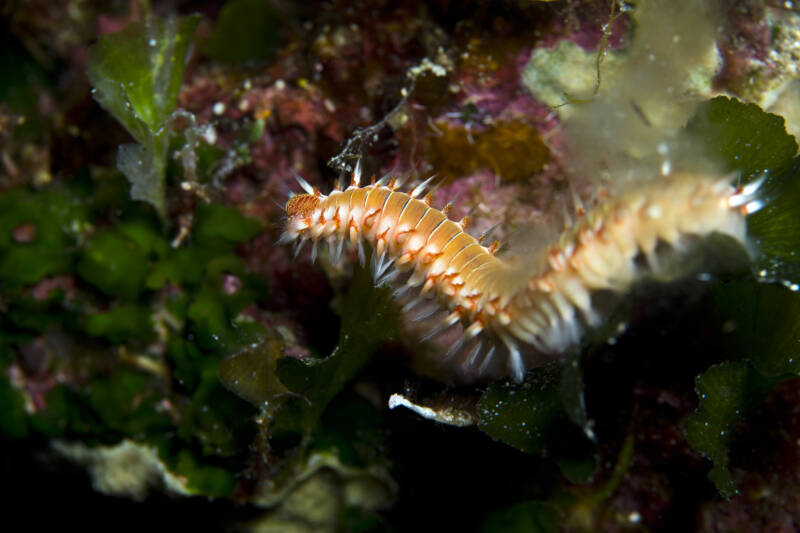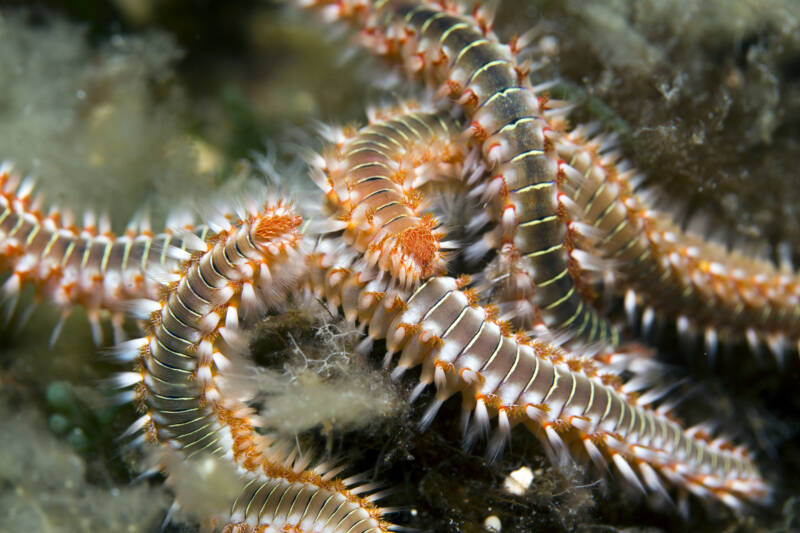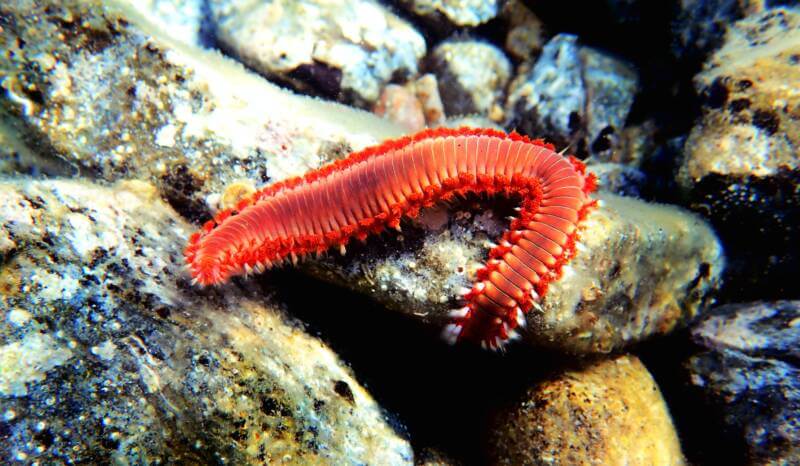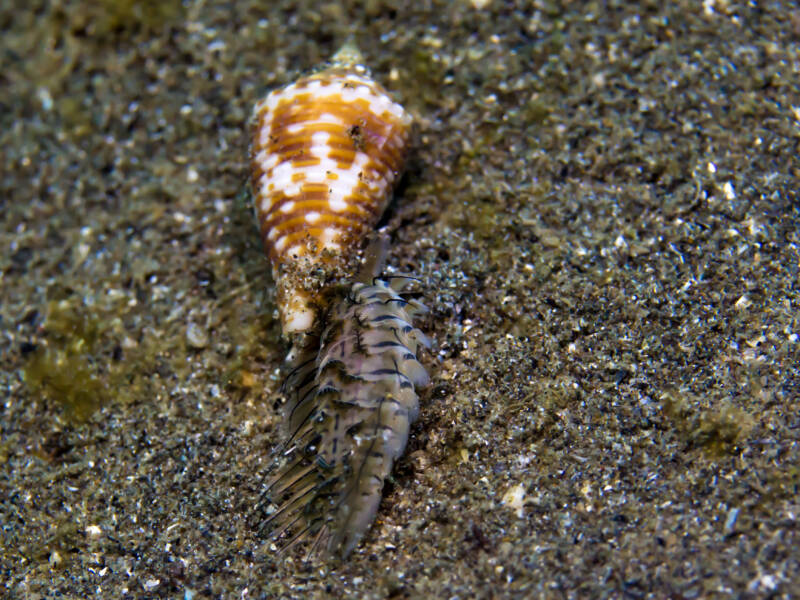If you are going to keep a reef tank as a hobbyist, then you need to know how to spot and deal with bristle worm.
In this post, you will learn everything you need to know about bristle and be prepared to deal with it in the best way should it appear.

[toc]
What’s a Bristle Worm?
Part of the fun of keeping an aquarium is creating a balanced ecosystem of plants, rocks, and fish.
You’ll find creatures that thrive in the same environment and can be kept together, and then watch them all live among each other like a tiny microcosm of their natural habitat.
This is part of the magic of keeping a tank, but it’s also a BIG part of the challenge! One example is the bristle worm or the Polychaeta. So just what is this?
Technically, bristle worms are a form of marine pest.
These are not the only type of pests or diseases that you’ll encounter by a long shot, but bristle worms are among the most common.
What’s more, is that bristle worms are very difficult to get rid of and are known to cause a range of different issues in marine tanks.
That said, they aren’t always bad, and there is such a thing as good bristle too!
Some people even recommend that you keep most types of bristle worm in your tank. Others will recommend that you destroy them with extreme prejudice!

Confused yet?
Bristle worms are technically categorized as polychaetes, soft-bodied annelids.
They are called bristle worms because of the tiny bristles or many hairs that cover the side of their body. These bristles are hollow in some cases and barbed in others and they will often break off when brushed against by fish or other critters living in your saltwater tank.
This can cause irritation in itself, but worse is that bristle worms can actually be venomous in some cases! Here, the tiny spines are actually poisonous and can cause irritation to many fish species.
What’s more, is that bristle worms often have powerful jaws that they use for feeding. They may sometimes bite other animals in your tank, causing further harm.
They can also actively feed on corals, which can damage them. All in all, not good!
To look at, bristle worms are a little bit like millipedes. They can appear in a variety of different colors though are often red or orange in hue.
Bristle Worm Behavior
What do bristle worms do?
Bristle worms will mainly keep themselves to themselves. That means they’ll wander around your tank minding their business looking for food.
Other species will actively tunnel or make tubes, which they can then use to collect prey that comes to them.
One of the most dangerous species is Fireworm. It can grow as large as 12 inches long and will actively feed on corals and anemones.
They are among the species with hollow, poisonous bristles, which can be extremely bad for any fish in your tank.

Can bristle worms kill fish?
It is not common for bristle worm to kill fish, but it is also not unheard of.
Generally, the poisonous bristles on these critters cause irritation rather than a fatality. But if your fish is already struggling, this certainly won’t hurt its chances.
On rare occasions, very large fireworm have been known to actively attack fish such as wrasses! These large creatures can actually wrap themselves around the fish and may even attempt to eat them.
If you see this happening, you may be able to intervene using tongs – but keep your hands far away from the tank!
This is rare, but it’s certainly something to keep an eye on. And if you wake up to a dead fish, any worms on the larger end should certainly be considered suspects!
What do bristle worms eat?
Bristle worms are scavengers, meaning that they will tend to munch on whatever they find – predominantly organic debris. Common examples of detritus they enjoy include algae growths, plankton, and even dead fish.
As mentioned, they can actively feed on corals too. This is one of the biggest reasons why many people want them gone from their tanks.
How Did Bristle Worm Get in My Tank?
As mentioned, nature is wild and untameable.
As many gardeners know, nature finds a way. Life is hardy, and it will quickly fill any environment available to it. That definitely includes the nutritious, warm, and wet environment of your reef tank!
But the bristle worm still had to come from somewhere right? Well, there are a few possible sources.
One common one is live rock. Live rock is rock pulled from natural environments such as rock pools and the seafloor and then placed straight into your tank.
There’s a reason that this is referred to as “live” rock. That includes not only bacteria but also bristle worm.
Live rock can be found naturally, but it can also be bought from fish stores. If you are buying live rock, then it is very important that you inspect those rocks thoroughly for bristle worm first.
Note that bristle worms, like other segmented worms, can regrow large parts of their body.
If you attempt to remove the bristle worm yourself, you may find that part of it breaks off leaving the most important part of its body on the rock. This can then regenerate.
Use tweezers, and then grasp the worms firmly as close to the base as you are able to.
Spotting the Bad Guys

So how do you spot the bad worms from the good bristle worms?
One answer is by doing your own research. It can be hard to spot bristle worm (they tend to come out at night), so it’s worth turning off the lights and then jostling the substrate.
From here, if you can get a photo, you can then post those images to forums or compare them against Google Images.
The most common “bad guy” bristle worm though is the Fireworm (Hermodice carunculata).
These are poisonous and they can really hurt if they get you! Fireworms are also classified as carnivores and as such, have among the strongest jaws.
Fireworms are reddish along the bristles while the bristle tips themselves are white. They also have a segmented body that has brown, red, yellow, or green gill filaments.

How to Get Rid of Bristle Worms
So you wake up one morning and you realize that your beautiful saltwater aquarium is crawling with these little worms. It’s time to get to work catching and removing those worms. What can you do?
As mentioned, these segmented worms can be difficult to completely remove – and you shouldn’t use bare hands as those many hairs can irritate human skin too.
PVC Pipe Trap
One of the best strategies is to create a trap for your worms.
A popular ploy is to use a piece of PVC pipe. Drill small holes through the length of the pipe, place some shrimp inside and then shut off either end. This is catnip for those worms.
During the night, the bristle worms will crawl into the pipe, and – as long as you have kept those holes small – they won’t be able to get out so quickly.
And anyway: they don’t know what’s coming so probably don’t realize they need to get out! (Of course, you also want to keep the holes nice and small so that you only catch polychaete and not fish!).
Now in the morning, you can simply unplug one end of the pipe and then pour those worms away!
This method works very well but won’t necessarily capture 100% of the worms right away.
You may, therefore, wish to repeat this process for a few nights to capture as many of the intruders as you can.
Nylon Stocking Type of Trape
Another option is to use a piece of food with a nylon stocking.
You can again use shrink or scallop, but this time the aim is to get the worms stuck to the sock. Those many hairs will get caught in the little holes in the stocking, and you can then throw them out quickly.
Repeat both these methods for a few weeks and you can remove a LOT of the worms.
Natural Bristle Worm Predator

Finally, you might consider investing in a natural bristle worm predator.
Good examples include arrow crabs or even certain wrasses such as a sunset wrasse! This is a particularly good strategy because it is completely natural.
Keep in mind that even if you are very thorough, you might have a hard time completely removing all of the worms this way as they can burrow under your substrate and hatch larvae.
For that reason, it might be worth completely emptying the tank, getting rid of all your sand/gravel, and even manually removing them from your rocks.
Why Might You WANT Bristle Worms?
But before you go ahead and do that, keep in mind that some people actually recommend you KEEP your bristle worm.
Why? Because they can form a natural and healthy part of the little ecosystem you have going on here!
The thing to recognize is that there are different species of bristle worm – and each behaves differently.
Of course, the type of bristle worms that you don’t want is a poisonous kind.
But remove this issue, and you’ll find that these guys can serve as your own private clean-up crew! This is because they are perfect for waste management.
Remember how we said that bristle worm ate leftover detritus? Well, a lot of that happens to be stuff that you probably don’t want in your tank: food no one wants to eat, skin shedding, and even feces! These critters are grateful for it all, and will go around your tank hoovering it up!
On top of that, bristle worm can also be useful for aerating your substrate by burrowing their tiny tunnels into it.
Another handy fact is that this cleanup crew will only reproduce based on the available food. This means that one of the best ways to prevent being overrun by bristle worm is to avoid overfeeding your tank.
Closing Thoughts
So that’s what you need to know about bristle worms and your saltwater tank!
It can be alarming to spot a bristle worm, but it’s not always bad news. In the best-case scenario, bristle worms can become an important part of your little ecosystem and help to keep your tank clean and healthy.
But hopefully, now you know how to spot the bad types of bristle worm too, and to keep your reef safe when they do become a problem.
